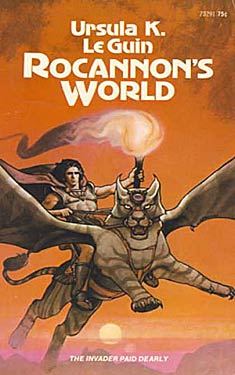Ursula K.
LeGuin
Completed 12/18/2018,
Reviewed 12/20/2018
3 stars
This is Le
Guin’s first published novel, and the beginning of what later became known as
the Hainish Cycle. It has a prologue which
takes place many years before the rest of the novel. The prologue was originally released as a
short story, and reads like one. The
book as a whole is not a great book, but it is entertaining, sort of a mix
between fantasy and science fiction. It
has a mythic journey with beings that are like elves and dwarves, and
introduces such concepts as the Ekumen, known here as the League of All Worlds,
and the ansible, the instantaneous faster than light communication device. I enjoyed the book, but this was not her
best. This book was part of a collection
of her first three Hainish books.
 The book
begins with Semley, the queen of her race, one of three races of intelligent
beings on the planet known only as Formalhaut II. She and her husband are no longer wealthy,
but she remembers an heirloom necklace that belonged to the family many years
before. She decides to search for it
among one of the other races. She finds
it in the most amazing of places, but its discovery also leads to heartbreak
later.
The book
begins with Semley, the queen of her race, one of three races of intelligent
beings on the planet known only as Formalhaut II. She and her husband are no longer wealthy,
but she remembers an heirloom necklace that belonged to the family many years
before. She decides to search for it
among one of the other races. She finds
it in the most amazing of places, but its discovery also leads to heartbreak
later.
Fast forward
a generation, and Gaverel Rocannon, a Hainish scientist, is shipwrecked on
Formalhaut II. The planet is being
attacked by a planet that is rebelling against the Ekumen, unbeknownst to the
League. Rocannon wants to warn the
Ekumen, but the only way he can is to infiltrate the enemy’s base and use their
ansible. He embarks on a journey to the
base, taking along Semley’s grandson, and several other companions from the
other races. They fly on creatures that
are a sort of winged tiger for most of the trip. As the journey progresses, Rocannon becomes a
mythic figure himself to the planet and to the Ekumen.
The plot
moves along at a fairly decent pace.
There’s action in this book. The
journey is not simply an opportunity to reflect on concepts, but things
actually happen. For example, Rocannon
gets separated from the team and gets captured by a group of barbarians. They try to behead him and burn him at the
stake, believing him to be a spy of the north.
What this
book is lacking is Le Guin’s signature prose.
It’s evident in the prologue, but not so much later on. It felt choppy in parts. At times, it didn’t even feel like a Le Guin
novel, but rather a pulp novel from the fifties. I blame that on this being her first
novel. I’m already reading her second
novel and the prose in that book is leaps and bounds better.
I give this
book three stars out of five. It’s
decent, but not her best. Perhaps the
best thing about this book is that it gives you the foundation technology for
the science in the rest of the Hainish Cycle.
While each book I’ve read so far in the Cycle is a standalone story, it
was interesting to see how the concepts were initially introduced. Since a lot of people have already read “Left
Hand of Darkness” and/or “The Dispossessed”, suffice it to say that the books
can be read in any order. While I only
thought the book was okay, it was fun to see where it all started.
No comments:
Post a Comment